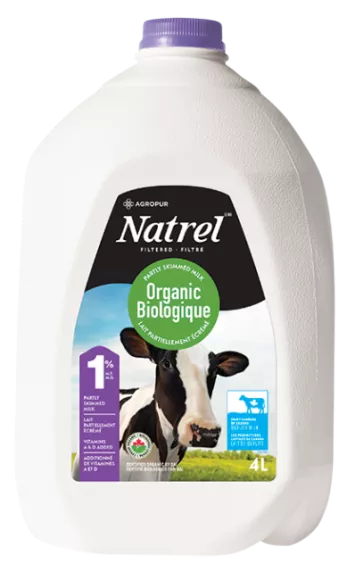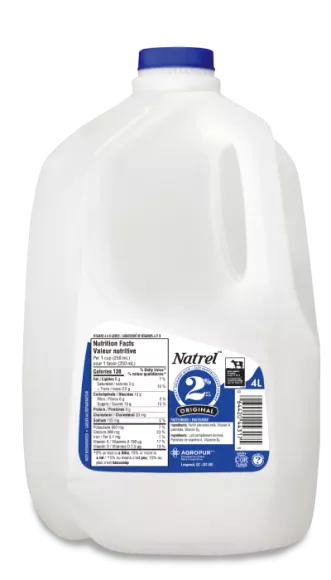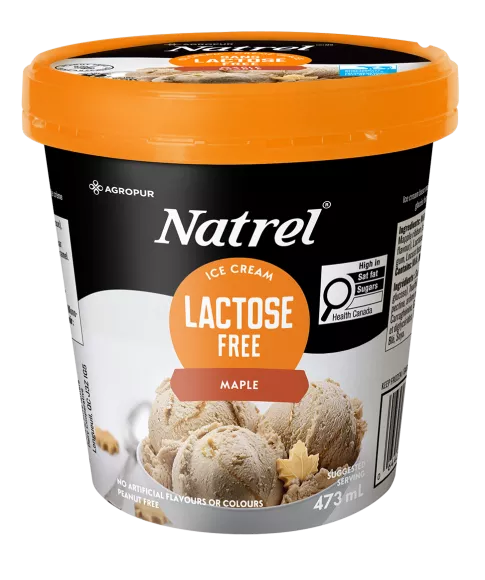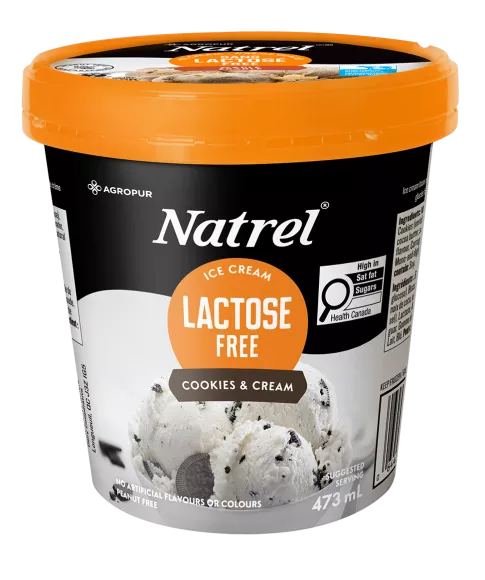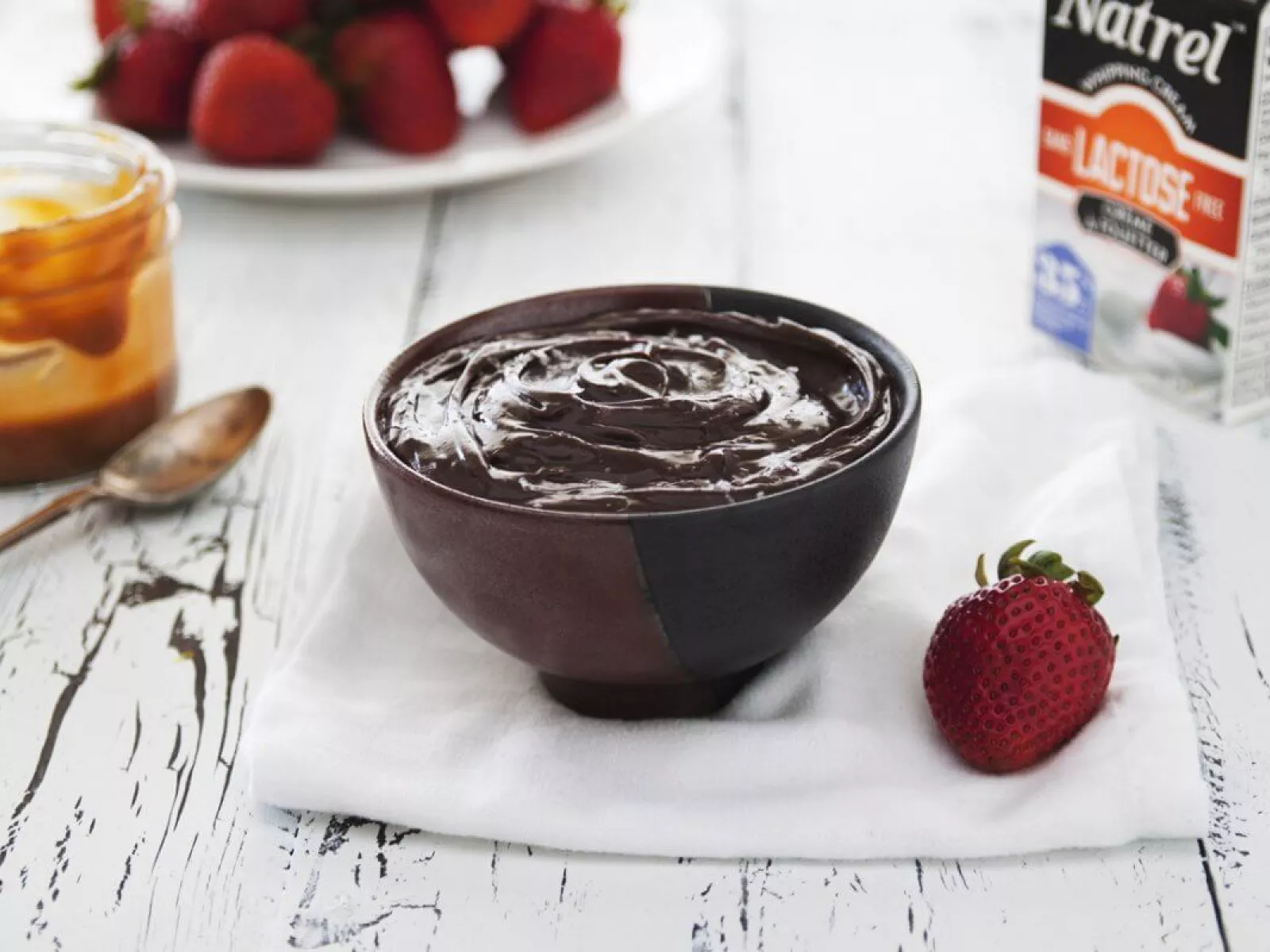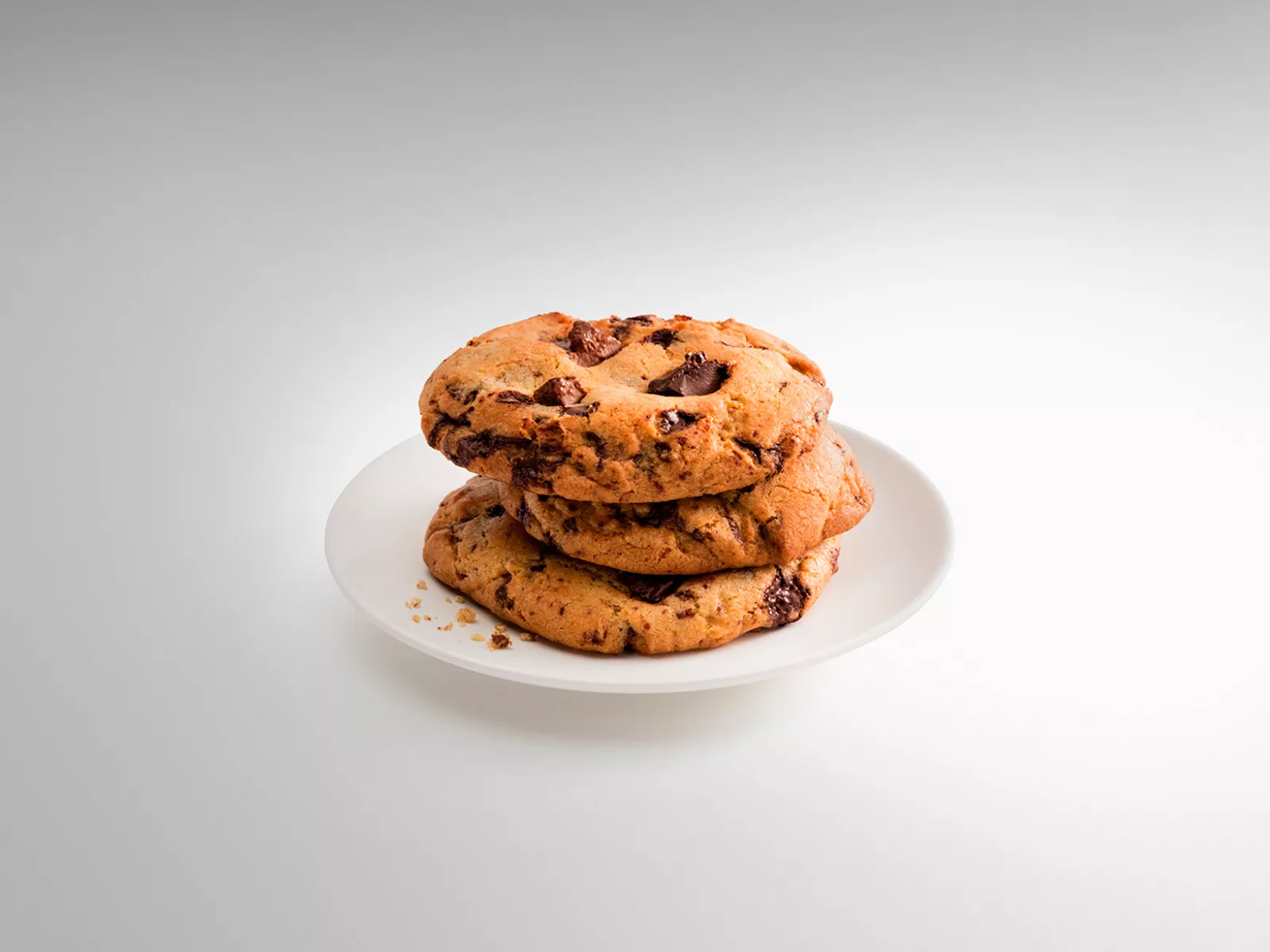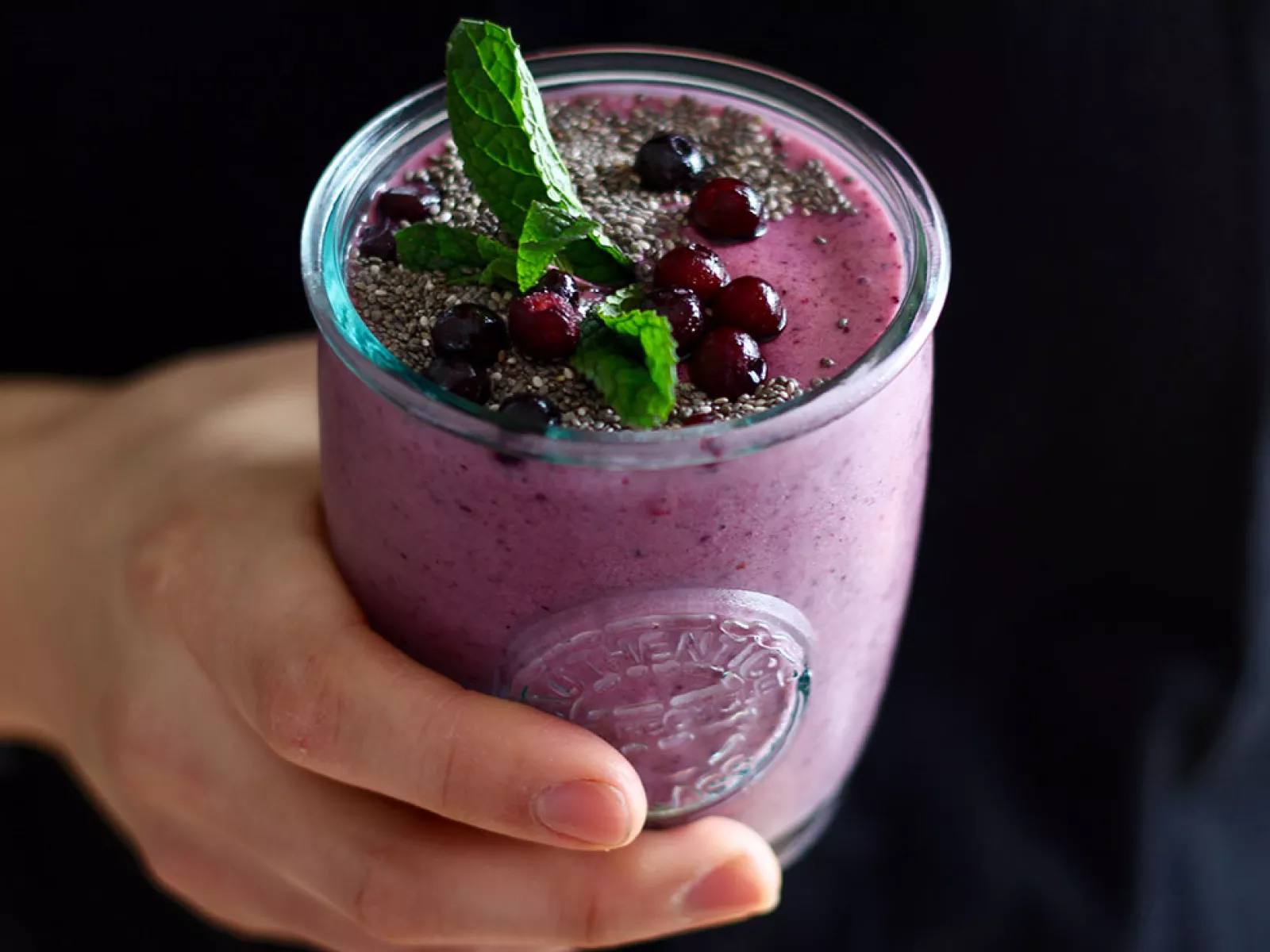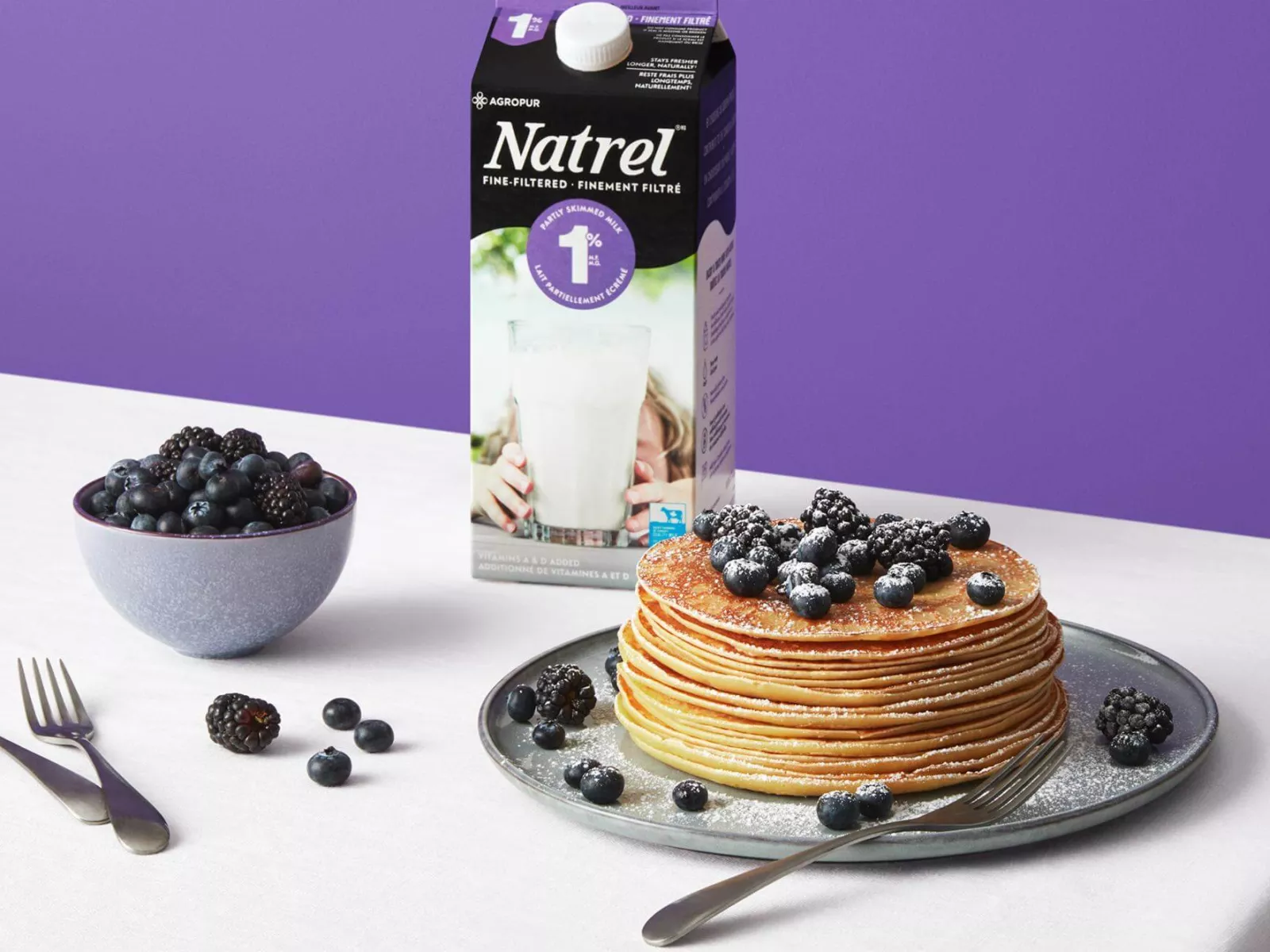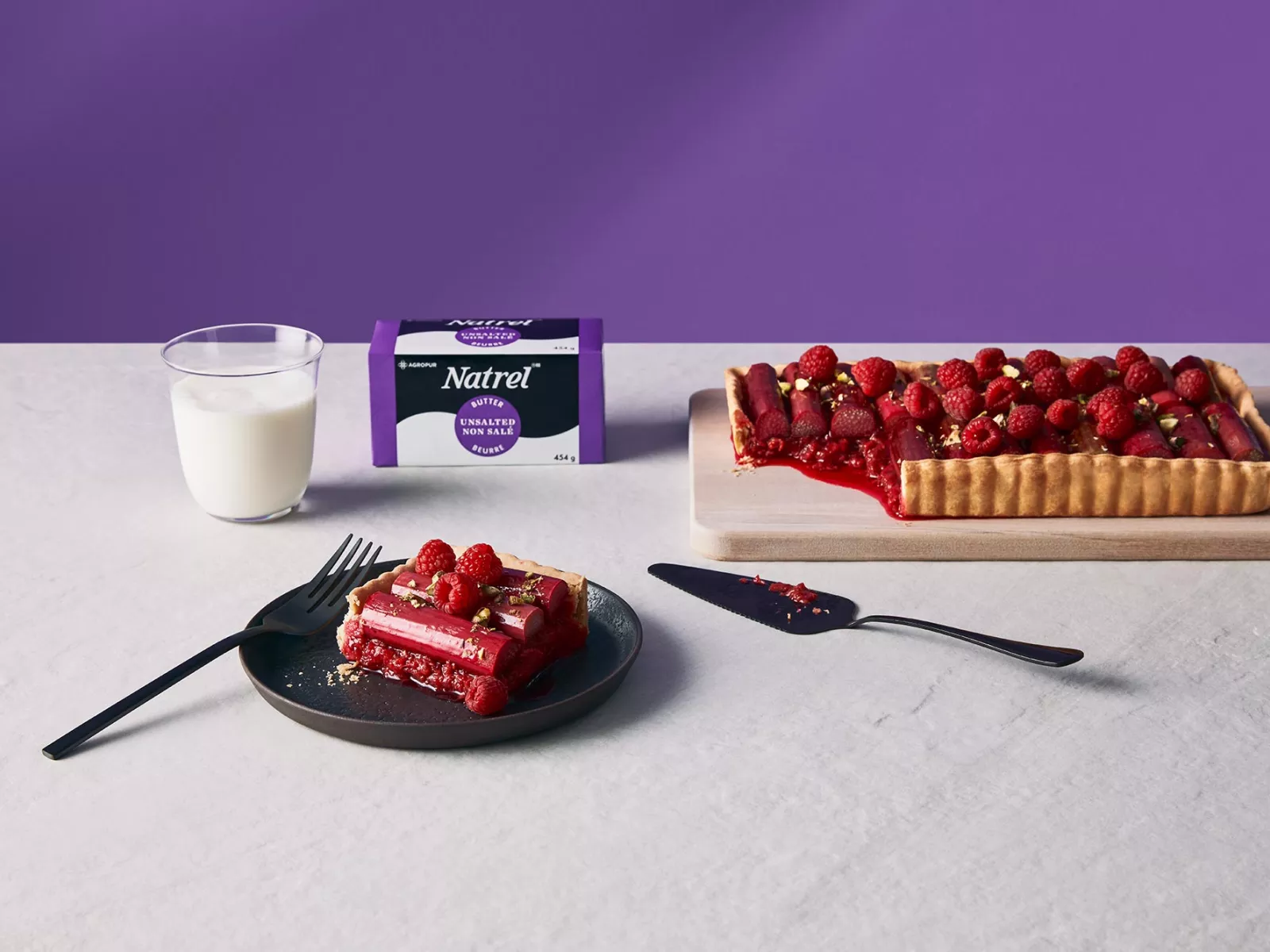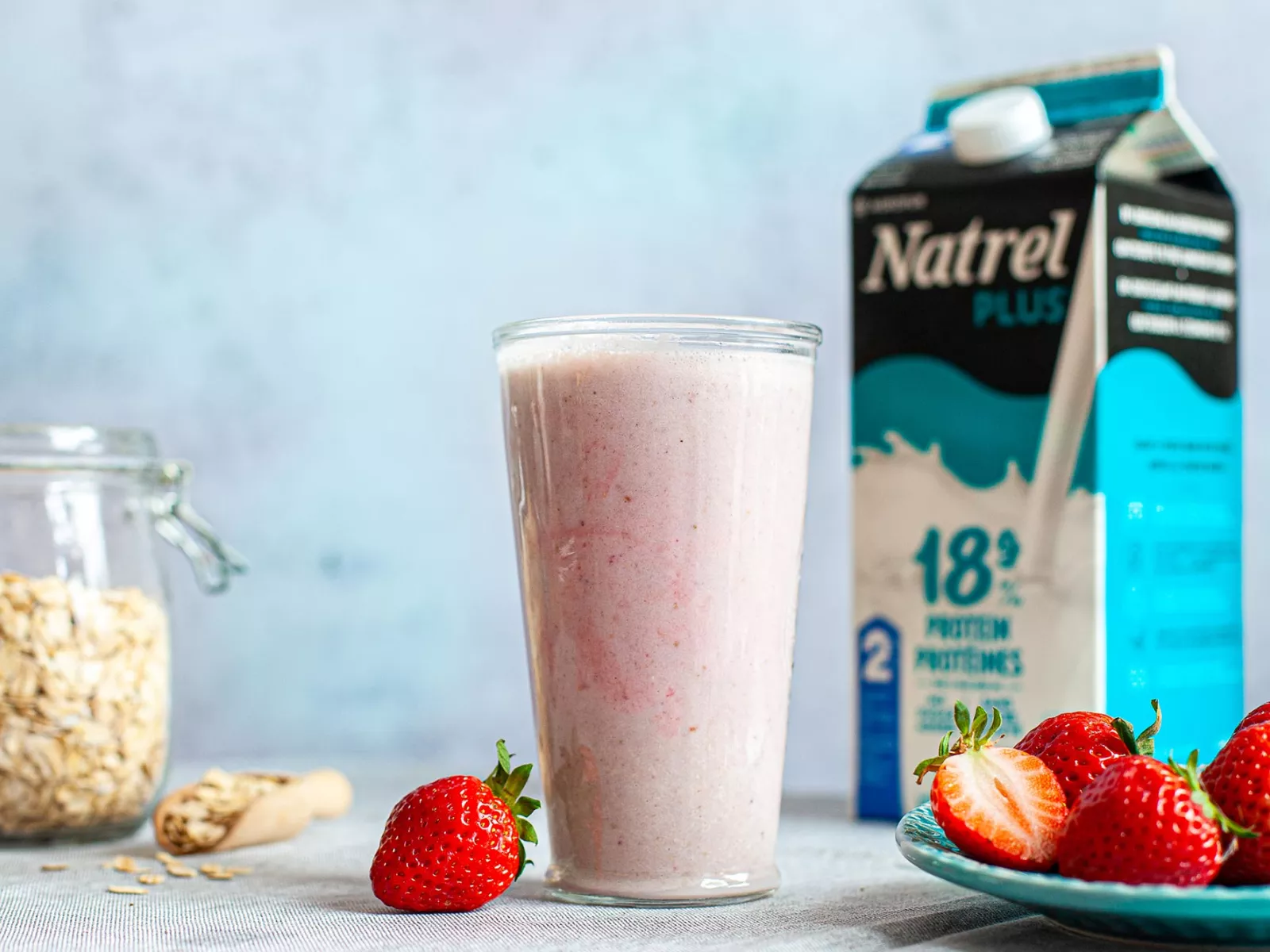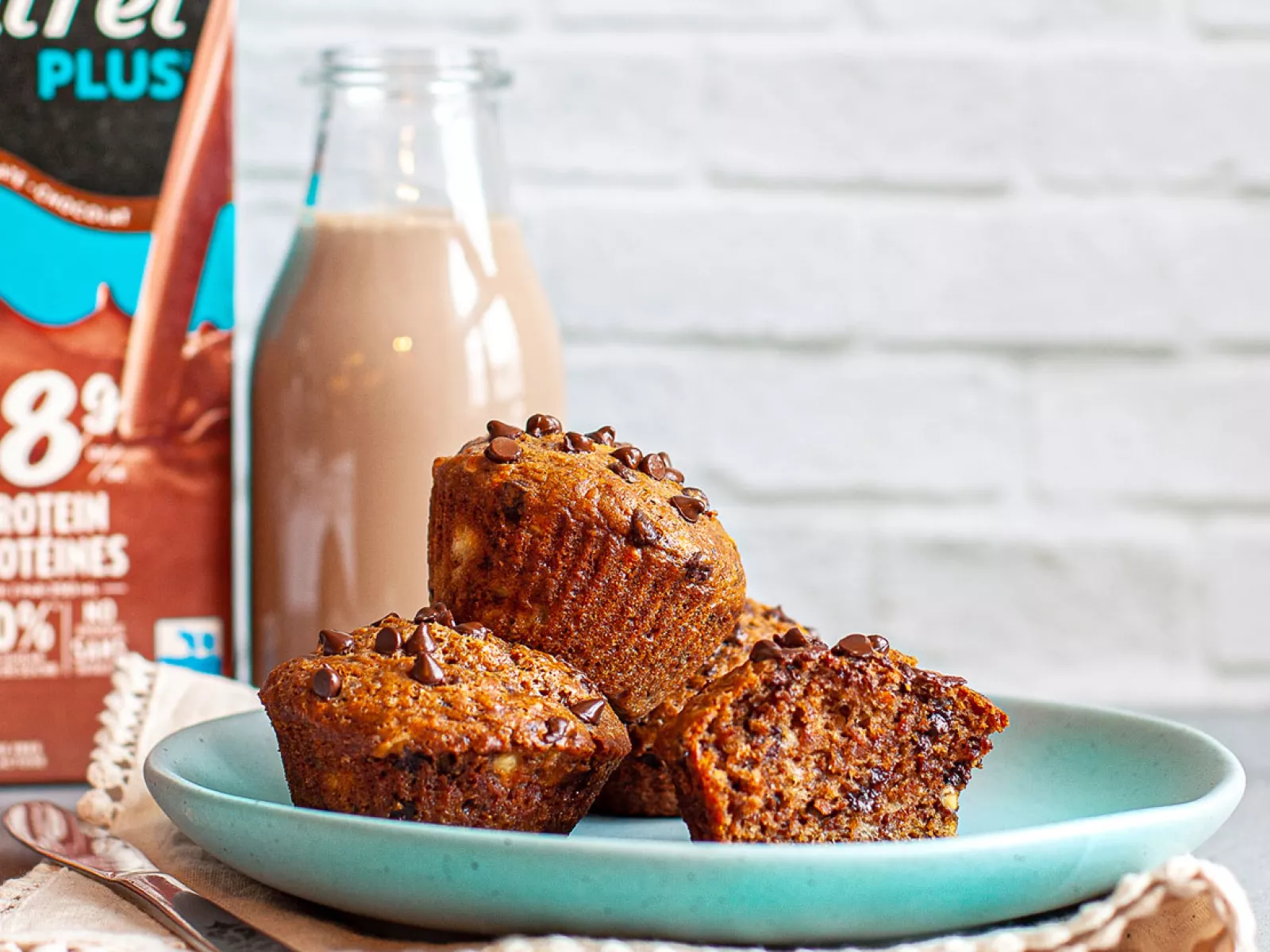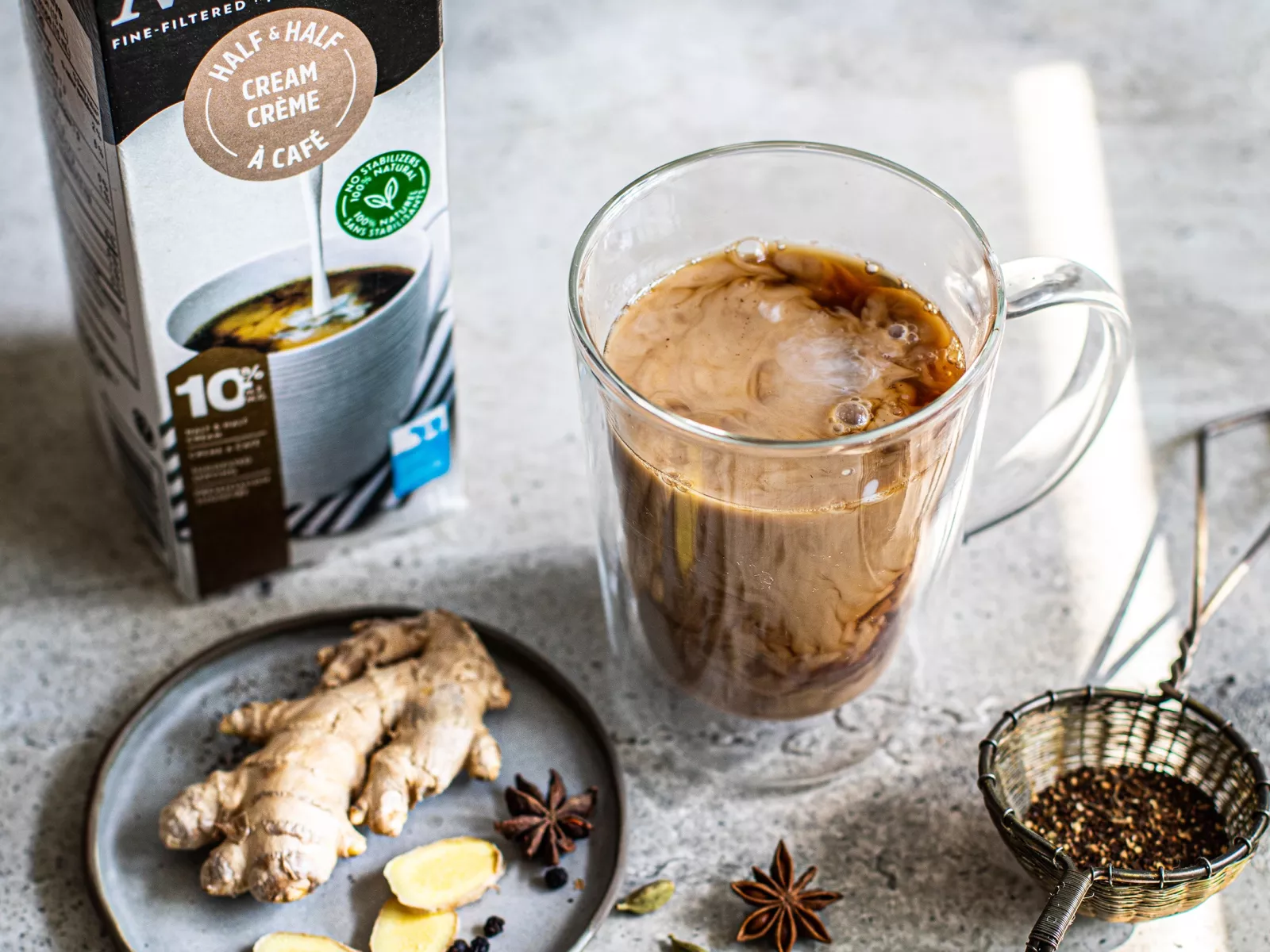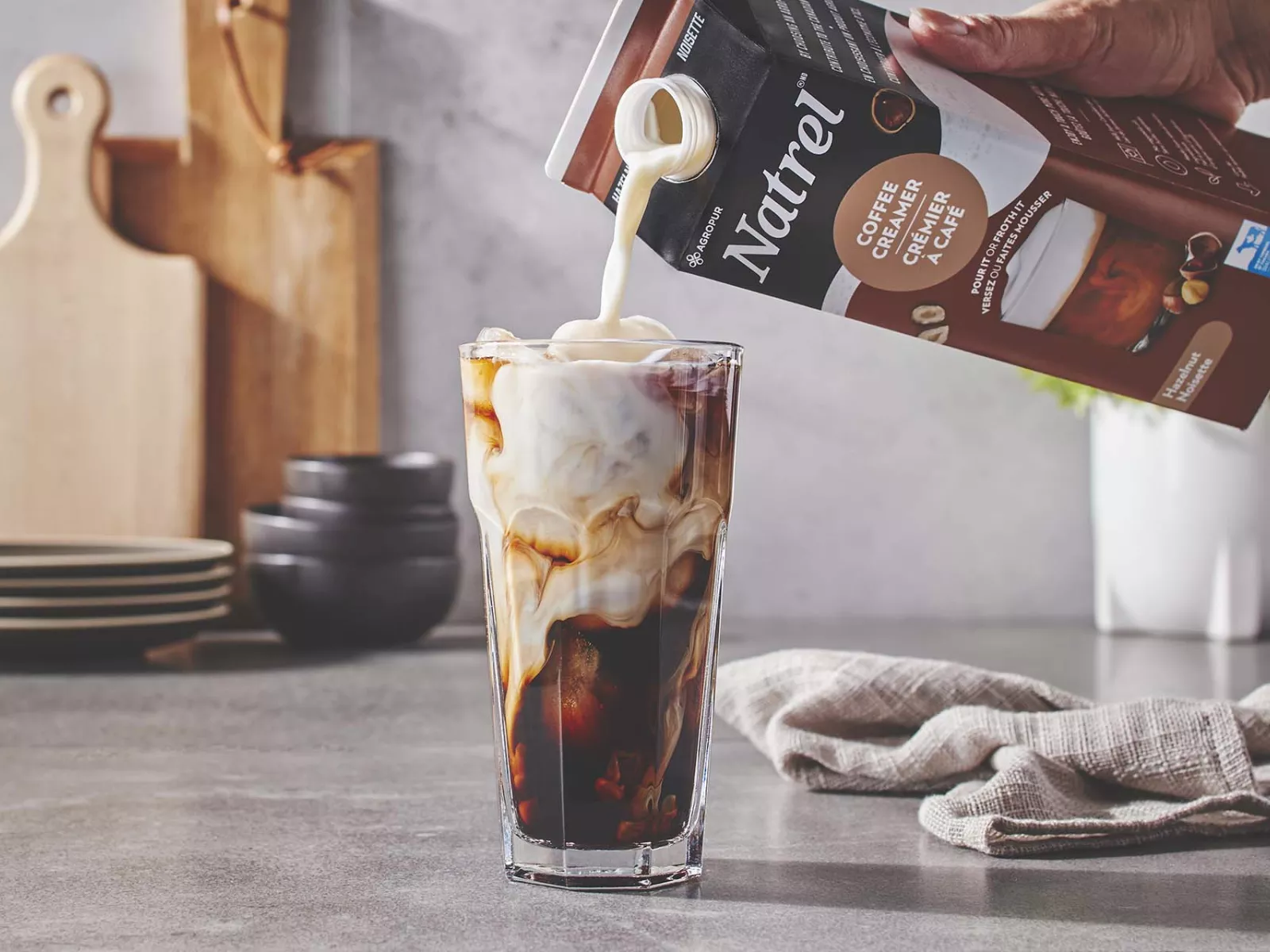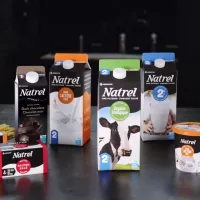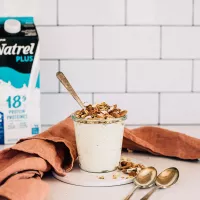Our products are usually available at grocery stores, convenience stores, mass merchants and warehouse clubs. Head to the Find our products section for product availability by province. If you’re having trouble finding our products, go to the contact us section of our website and send us a message by filling out our Contact Form. Upon receiving your request, we will send you the name of a store near you that carries our products.
Search
Looking for a touch more?
Subscribe to our newsletter to get promotional offers and exclusive content.
Products (52)
Recipes (126)
Vanilla, Spicy Apples & Pistachios Pancakes
Protein milkshake with strawberries & muffin bites for dipping
Protein-Packed Chocolate Overnight Oatmeal with Seed Crust and Frozen Fruit
FAQs (70)
Natrel Fine-Filtered Milk, like all milk, is pasteurized. However, our filtration process can remove virtually all the bacteria to give our milk a purer taste that stays fresh longer, naturally, than milk that has only been pasteurized.
We recommend that you keep Natrel Butter in the refrigerator in its original foil covering. This way, you can keep it for up to three weeks once opened. If you think you will be keeping it longer, we suggest you wrap it further in a piece of aluminum foil to preserve its fresh taste longer.
If you like your butter soft, you can keep a small quantity on the counter, in a covered butter dish, for two or three days.
Natrel Butter freezes well if it is first wrapped in a plastic freezer bag. When properly wrapped, Natrel Unsalted Butter will keep for three months and Natrel Salted Butter will be good for a full year. When you are ready to use it, leave your Natrel Butter to thaw in the refrigerator for a few days to obtain the best possible texture.
Source: http://www.dairygoodness.ca/butter
Natrel Salted and Unsalted Butters are available in Quebec, Ontario, British Columbia and Atlantic provinces in selected supermarkets and warehouse club locations.
Natrel Half-Salted Butter is available in Quebec in selected supermarkets.
Natrel Lactose Free Butter is available in Quebec, Ontario, British Columbia, Alberta, Saskatchewan, Manitoba and Atlantic provinces in selected supermarkets.
Natrel Organic Butter is available in Quebec, Ontario, British Columbia, Alberta, Saskatchewan, Manitoba and Atlantic provinces in selected supermarkets.
If you’re having trouble finding our products, go to the Contact Us section of our website and send us a message by filling out our contact form. Upon receiving your request, we will send you the name of a store near you that carries our products.
Although our Natrel Flavoured Milk products are delicious all on their own, their rich, creamy taste can definitely make your recipes truly inspired, giving them that little something extra that’s distinctly you. Pancakes with Natrel Dark Chocolate Milk? Sure. Muffins with Natrel Partly Skimmed Maple Milk? Absolutely. With Natrel Flavoured Milk, you can let your imagination run free.
For more inspiring ideas, visit our Recipes section : www.natrel.ca/en/recipes
Our organic milk comes from organic farms that comply with rigorous standards (Canadian Organic Standards) established by Quality Assurance International. Indeed, our Organic Fine-Filtered Milk comes from Canadian dairy farms dedicated to organic farming principles.
Yes, of course. We offer Natrel Organic Fine-Filtered Milk in Ontario and Quebec. We also sell Natrel Organic Milk in British Columbia. Our Natrel Organic Milk comes from organic farms.To find out where you can buy our organic products, visit our Natrel Organic Products page.
Natrel Fine-Filtered milk does not contain any preservatives. We use a series of pasteurization and filtration methods to make Natrel Fine-Filtered Milk’s shelf life longer. Unless you purchase Natrel Calcium and Natrel Omega-3, only vitamins A and D are added to the milk.
Through our filtration process, we can give our milk a pure taste that stays fresh longer, naturally - without any preservatives. Our packaging with the "fresh-seal packaging" stamp also helps preserve the delicious, fresh taste of this product.
We do not just pasteurize our milk. We filter it to remove virtually all the bacteria that shorten its shelf life and give it a purer taste that stays fresh longer, naturally - without any preservatives.
It refers to the bacterial cultures added during the cheese-making process that cause the lactose to naturally diminish throughout the ripening period. It ensures that the product is 100% lactose-free and can be enjoyed by all cheese lovers without the discomfort.
Of course! Our lactose free dairy products can be used in any recipe that calls for dairy products.
Here are a few recipes to get you inspired; Just select Lactose Free as a filter: www.natrel.ca/en/recipes
From the start, we’ve strived to keep the delicious taste of fresh milk. We’re proud to produce lactose free products that have the same fresh milk taste that you love.
Good news: Natrel Lactose Free products can be compared to the regular dairy products’ health benefits. They are a great source of protein, calcium and vitamin D. Check out our products’ nutritional information for more details.
Yes, the Maple Ripple in the ice cream contains real maple syrup, as well as natural maple flavour.
Each element used for our ice cream mochis packaging is recyclable. The packaging has been designed to ensure optimal product quality from manufacture to tasting.
The centre of our mochis is made of premium ice cream. It’s Natrel ice cream, so it’s made with 100% Canadian milk. There are three flavours to choose from: triple chocolate, vanilla, and mango. The ice cream is wrapped in thin, slightly sweet rice dough. All Natrel mochis contain no artificial colours or flavours.
It is indeed recommended to shake well to ensure that the naturally occurring fat in the products are well mixed for an optimal taste.
This product contains only one allergen: milk.
The chocolate flavour is a natural, allergen-free flavour.
Natrel Plus is a new line of protein-rich milkshakes made from our ultra-filtered lactose-free milk. Four types are currently available: two white dairy beverages with either 2% fat or 3.25% fat, a chocolate-flavoured dairy beverage with 1% fat and a vanilla-flavoured dairy beverage with 1% fat.
Protein content is what differentiates the Natrel Plus line from our Natrel fine-filtered milks: each 250 ml portion (1 cup) of Natrel Plus provides 18 g of protein, or twice as much as regular milk (which contains an average of 9 g per 250 ml, according to the Canadian Nutrient File).*
*Based on the protein content per 250 ml indicated in the 2018 Canadian Nutrient File (CNF) for partly skimmed milk with 2% fat (code: 61).
The proteins in Natrel Plus products are not just any old proteins added to milk: they come entirely from our 100% Canadian milk.
Thanks to our filtration process, the milk proteins are concentrated and combined with the other ingredients in order to control the source, quality and quantity of the proteins added to our products.
Yes, all Natrel Plus products are lactose-free because they are made from our fine-filtered lactose-free milk.
This means that this cream is made from milk from Canadian organic dairy farms. These farms meet strict criteria set by QAI (Quality Assurance International). This cream meets Canadian standards on organic farming. It is also naturally GMO-free and contains no antibiotic or artificial growth hormone.
*according to regulation currently in force in Canada, milk cannot contain antibiotic residues and artificial growth hormones are not approved for use in dairy cattle.
This means that both creams contain only two ingredients: fine-filtered skim milk and cream. These creams are pure and simple, with no food additive.
Food additives are substances added to food to preserve or enhance its flavor, taste, appearance, texture and aspect. Some additives and other types of ingredients have been used for centuries, for preserving food, by salting (bacon or fish), adding sugar (jam, fruit preserves) or by using sulfur dioxide, as done with wines.
Many different food additives have been developed over time to meet the needs of food production, as making food on a large scale is very different from making them on a small scale at home. Additives are needed to ensure processed food remains safe and in good condition throughout its journey from factories or industrial kitchens, during transportation to warehouses and shops, and finally to consumers. For cream, the food additives are used to enhance the stability of the product in contact with heat.
It is possible that the products make small particles when poured into a coffee. This reaction is completely normal and does not mean that the product is unfit for consumption. Just stir for the coffee and cream to mix.
Pasteurization involves heating milk to temperatures high enough to eliminate certain unwanted bacteria while retaining the nutritional properties of milk. In most modern methods, milk is heated to 72 °C (161.6 °F) for 15 seconds or to 140 °C (284 °F) for three seconds then rapidly cooled to 4 °C (39.2 °F). It does not involve the use of any additives whatsoever. Pasteurization not only makes the milk suitable for consumption, but also increases the length of time it can be kept before it spoils.
Although it is carried out at different stages, depending on the product, pasteurization is a step in the manufacturing process of every dairy product except for some cheeses made with thermized milk.
UHT (Ultra-high temperature) and HTST (High Temperature Short Time) are two pasteurization methods. The main difference between UHT and HTST milks is the intensity of the heat treatment which influences the shelf life of dairy products.
What is meant by shelf life? Shelf life refers to the period that milk can be stored before it starts to spoil. It is influenced by several factors such as the manufacturing processes, the way the product is packaged, storage conditions and whether the product has been opened, etc.
UHT is a processing technique used to make dairy products stay fresher, longer. UHT means that the milk is heated to about 140°C (284 °F) for around 4 seconds. This method eliminates essentially all the bacteria in milk. The average shelf life of UHT milk is 40-65 days if unopened and refrigerated appropriately. After opening, UHT milk should be kept refrigerated between 1°C to 4°C (33.8°F-39.2°F) and consumed within 7-10 days.
On the other hand, dairy products pasteurized using the HTST method are heated to about 72 °C (161.6 °F) for around 15 seconds to remove certain bacteria. Unopened HTST pasteurized milk products have a shelf life of 12–22 days. Once opened, HTST milk should be kept refrigerated between 1°C to 4°C (33.8°F-39.2°F) and consumed within 7-10 days.
Osteoporosis is a disease that causes low bone mass and deterioration of bone tissue. Bones become less dense, lose strength and break easily, particularly the hips, spine and wrists. The loss of bone mass usually occurs without symptoms, so many people are unaware that they are at risk. Vitamin D and calcium promote bone density and milk is an excellent source of calcium.
Virtually all body cells, including those of the heart, nerves and muscles, need calcium to function properly. Calcium is essential for building and maintaining strong bones. It helps maintain a normal heartbeat, regulates blood pressure, and can also help reduce the risk of high blood pressure. Calcium is important for normal blood clotting, which is essential to healing. It helps control muscle contraction and relaxation and can help prevent colon cancer in certain people. Calcium is also essential for the proper functioning of the nervous system.
Homogenization is a process used to evenly disperse and break down the fat particles in milk to avoid separation of the cream. It is a physical process, and nothing is added to the milk. Milk containing 3,25% milk fat (m.f) is also commonly called homogenized milk but refers to high-fat milk (whole milk).
Yes, there is a difference between these two processes. Homogenization is a process used to evenly spread and break down the fat particles in milk to make sure the milk has a smooth and uniform consistency. On the other hand, pasteurization involves heating the milk to eliminate bacteria while retaining the nutritional properties of milk. Milk containing 3,25% milk fat (m.f) is also commonly called homogenized milk but refers to high-fat milk (whole milk).
No. Lactose intolerance is caused by a decrease in the body’s production of lactase. Lactase is an enzyme that helps digest lactose, the natural sugar found in milk. The most common symptoms of lactose intolerance are swelling, cramps and diarrhea. On the other hand, a dairy allergy is an immunological reaction to casein, the protein found in milk.
Yes! We are part of the Agropur family which offers the best-selling lactose-free dairy products in Canada. Our Natrel Lactose Free line will make you rediscover the great taste of fresh dairy, without the discomfort. For more information on Natrel Lactose Free products, click here.
Although our facilities are not certified as gluten free, the majority of our products do not contain any ingredients derived from gluten. Products that do contain gluten are labelled accordingly.
Throughout our lives, calcium is necessary for many of our body’s vital functions. Milk products are a good source of calcium as they contain large quantities of it in a form that is well absorbed by our bodies. In addition, since calcium is found naturally in milk, it is evenly distributed within the milk container. Therefore, the calcium from milk doesn’t sink to the bottom of the container the way it can when it’s added to other beverages, such as soy beverages. This makes milk and dairy beverages, including chocolate milk, a reliable source of calcium.
Calcium is an essential nutrient, which means it is a nutrient our bodies can’t make on its own. Therefore, we need to get enough calcium from the food we eat. Calcium helps build strong bones and teeth. Calcium is also needed for muscles such as the heart to contract, blood to clot, and nerve impulses to transmit in the body. If your calcium needs are not met through food intake, it will be withdrawn from your bones, which act as a depot for calcium. Milk products are excellent sources of calcium. Fluid milk contains vitamin D, which helps our body absorb calcium, and is equally important for bone health.
Without milk products in your diet, it is difficult (but not impossible) to meet your calcium needs. This is because very few foods other than milk products contain as much calcium that is readily absorbed by the body.
If the store already carries Agropur products, you may ask the manager of the dairy section to order the product you are looking for. If the product is still not on the shelves, contact us and we will gladly help you locate the product in your area.
No! In Canada, the use of growth hormones is prohibited for dairy cows and antibiotic use must comply with Canadian law. In addition, milk is tested at the plant for antibiotics. If antibiotics were found in the milk, the milk would be discarded.
Agropur uses only 100% Canadian milk in the production of its products. The symbol is a seal of origin that guarantees the dairy products you are buying are made entirely from 100% Canadian milk or milk ingredients.
Although the packaging is not made to be frozen, it is possible to freeze milk. Freezing does not alter the taste or nutritional value of milk, but its texture and appearance may be slightly modified. We recommend keeping milk in the freezer for no longer than three weeks. Milk should be thawed in the refrigerator and well shaken before consumption. Once thawed, milk should be consumed quickly. Finally, even if milk was frozen, it is recommended to consume it before its best before date.
Yes, buttermilk can be frozen if you don’t mind the separation that may occur. Be sure to thaw buttermilk in the refrigerator and gently stir or shake it to restore its texture. Once thawed, it can be used for cooking and baking.
*Tip: freeze the buttermilk in portions. This way, you will be able to thaw the desired quantity for your recipes.
Yes! You can sour your own milk by adding one tablespoon of either vinegar or lemon juice to one cup of white milk. Do not use milk that has soured or milk past its best before date.
Soy milk is extracted from crushed soy beans. It is a popular food because it contains vegetable proteins but no cholesterol, even though it contains other fatty materials. However, soy milk usually contains less calcium than cow’s milk.
Beside the best before date, Agropur prints the manufacturing plant’s permit number on its packaging. This number identifies where the product was manufactured. The other characters allow us to trace back the product to the device used to fill the container and in certain cases, the time at which it was produced.
Vitamin D3 is added to milk to maximize the body’s capacity to absorb the calcium it needs to build and maintain healthy bones and teeth. Also, it is a federal requirement to add vitamin D3 to milk.
Vitamin A naturally present in milk is found in the fat particles. The process of skimming milk reduces the amount of vitamin A. Therefore, vitamin A palmitate must be added to skim and partially skimmed milk. However, 3.25% milk has adequate amounts of vitamin A due to its fat content.
The mono and diglycerides used in certain of our products is extracted from natural oils and is not of animal origin.
Our milk can be given to children once they are weaned from breast milk or infant formula. We recommend consulting your health professional on the right time for your child to transition to cow’s milk.
The most important factor in retaining the quality of milk is temperature control. Milk and milk products should always be stored at a temperature between 1°C and 4°C (33.8°F-39.2°F) . Dairy products should also be kept in their original container. Also, put milk and milk products back into the refrigerator quickly as even short periods of time at room temperature can cause off flavors and spoilage before the ‘‘best before’’ date. Moreover, as milk is sensitive to odors, store it away from strong-smelling food.
If the carton is sealed, regular milk can be kept for 18-22 days at a temperature between 1°C and 4°C (33.8°F-39.2°F). Once opened, milk should be consumed before the expiry date and within 7-10 days.
Cream is a fresh product and we do not recommend freezing it. Its texture will be significantly different upon thawing. Instead of having a smooth, silky texture of fresh cream, thawed cream will tend to separate.
Milk and cream should always be stored at a temperature between 1°C and 4°C (33.8°F-39.2°F). Cream has a slightly longer shelf life than milk. Once the container is open, cream can be kept for 10 to 15 days while milk can be kept for 7 to 10 days.
Dairy workers mix together cream, milk, sugar, and stabilizers, then add flavoring to the mixture before it’s frozen. Other goodies like fudge, nuts, fruits, and chocolate chips are added to create your favorite flavors. ‘’Overrun’’ refers to the amount of air incorporated into the ice cream. More air makes for a lighter ice cream; less air makes it richer and creamier. Premium ice creams have very little air—they’re a bit harder to scoop, but worth the effort! The packaged ice creams go into a freezer for 2½ hours at -30 °C (-22 °F) to set. Then they’re stored in the freezer warehouse until delivery.
Home freezers are generally not as cold as commercial freezers. When you open and close the freezer door, the ice cream thaws slightly, and the warm air that comes in condenses and forms ice crystals.
To be called ice cream, a frozen dessert must contain a minimum of 10% milk fat. Economy brands usually have lower milk fat than premium ice cream. Ice milk must contain between 3% m.f and 5% m.f. Light ice cream refers to an ice cream than contains less than the minimal 10% milk fat required. Sherbet is a delicious fruity frozen treat that also contains a small amount of dairy. Frozen yoghurt contains active bacterial cultures and has a similar texture to ice cream with a lower fat content.
Once you’ve purchased your ice cream or novelties, it is important to get it into your freezer as quickly as possible to reduce the amount of temperature abuse it is exposed to. Once the product begins to melt and is then refrozen, the product will form ice crystals which reduces the product quality.
Ice cream products purchased for home should be kept at an optimal temperature of -27ºC (-15ºF).
Once purchased and taken home, frozen desserts stored in your freezer can be kept for three months (unopened) if stored in proper conditions. Once opened, ice cream can remain fresh for about three weeks. Avoid storing ice cream in the front end of the freezer, near the door, where it is constantly exposed to fluctuations in temperature.
The mono and diglycerides used in the ice cream base of our products is plant-based, listed as either vegetable or soy. There are many inclusions and ripples added to the variety of ice creams that also include mono and diglycerides for which the source can vary. If you have a question about a specific product and would like us to find out for you, please contact us.
People with diabetes are encouraged to consume dairy products every day since these are foods with high nutritional value and many health benefits. Also, milk has a low glycemic index, which has little effect on blood sugar.
A diabetic person should still watch two things when choosing a dairy product: carbohydrates and fat. According to specialists from Diabète Québec and Diabetes Canada, the carbohydrate content of a serving of dairy products should be between 12 g and 15 g, while the fat content should not exceed 2% (for milk and yogurt).
With only 9 g of carbohydrates per 250 ml serving, the Natrel Plus 2% m.f. perfectly meets these recommendations. Even Natrel Plus chocolate should be suitable for diabetics since its carbohydrate content is 13 g per 250 ml serving, half the amount in conventional chocolate milks.
Proteins do not increase blood sugar. They can even help to better manage diabetes, thanks in particular to their effect on satiety. That said, since diabetes is managed differently from person to person, we recommend that you consult a health care professional before consuming Natrel Plus products if you are diabetic.
https://www.diabetes.ca/managing-my-diabetes/tools---resources/basic-meal-planning
https://www.diabetes.ca/en-CA/managing-my-diabetes/tools---resources/the-glycemic-index-(gi)
Natrel Plus can be used in certain cooked dishes as a substitute for your regular milk such as cakes, muffins and pancakes. Of course, you can use Natrel Plus in your cold drinks, coffes and in your cereals to increase the protein content of your meals.
Yes, the coffee creamers can be frozen for a reasonable period of time.
The coffee creamer that has been frozen keeps its functions once unfrozen. It is important that the freezing isn't for a long period of time. Once the coffee creamer is liquid, shake it well.
Note: A fresh product will fill its primary functions in a more efficient way.
It is important to treat the coffee creamers the same way you treat milk, which means that you have to keep them to a temperature between 1°C and 4°C (33.8°F-39.2°F) at all times. Put them back in the fridge as soon as you are done using them, mostly during hot days.
Oil is used in non-dairy creamers to increase the percentage of fat. As Natrel's coffee creamers are made with milk and cream as well as natural ingredients, they are only at 4.5% of fat which comes from cream. The cream's fat offers a product that performs as well as others, but it stays natural with a shorter ingredients' list because the product doesn't need any stabiliser.
Our coffee creamers are different from other products on the market because of:
- Its natural origins; Natrel's coffee creamers are made from canadian dairy products at 100% and they don't have oil.
- Its low fat percentage (4.5%); the cream used in the product is the only source of fat, which is why the coffee creamers have their silky foam.
- Its versatility; Natrel's coffee creamers can certainly be used in your coffees, but they can also add flavours to your recipes! See for yourself!
- Its stability in both hot and cold coffees; our coffee creamers react well to both hot and cold coffee temperatures.
Frequent consumption of foods high in sodium, sugars, or saturated fats is likely to increase health risks such as strokes, obesity, heart disease, type 2 diabetes, high blood pressure, and certain types of cancer.
Front-of-package nutrition labeling is widely recognized by health organizations and the scientific community as an effective tool to help combat the rising rates of diet-related chronic diseases.
The production, which is now local, results in a recipe change. The new recipe meets Natrel’s high-quality standards in every way and has a different flavour profile, which is slightly sweeter than the original recipe. While the flavour will differ, you will receive the same high quality, nutrition and functionality you currently enjoy from our lactose-free milks.
Due to extraordinary demand for our lactose-free products, we decided to move its production out West to accelerate its availability and better serve the Western market. With this production change, we had to delist all 1L formats (in all milk fat percentages) in western provinces to focus on most popular product and formats. You can buy your preferred milk fat in the 2L format.
The new recipe for lactose-free milk will be produced in a BRC-approved (GFSI) and Kosher certified facility.
While the flavour will differ, you will receive the same high quality, nutrition and functionality you currently enjoy from our lactose-free milks.









